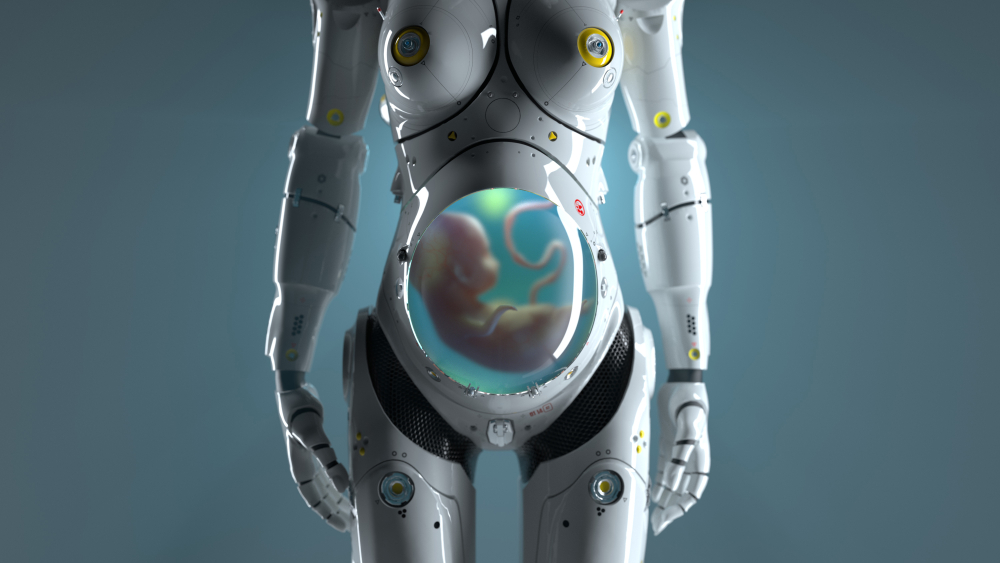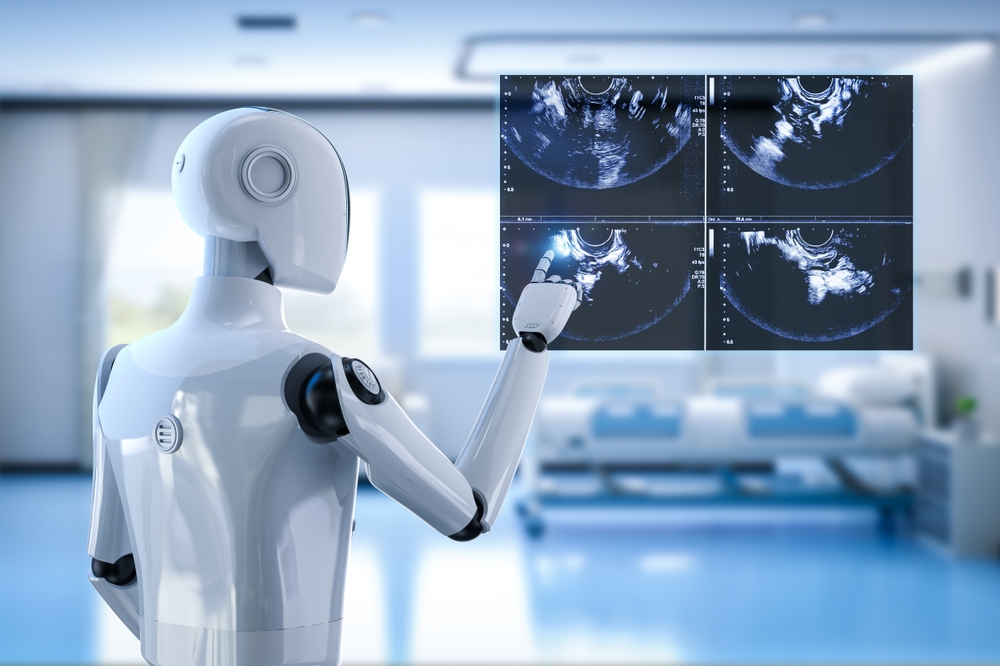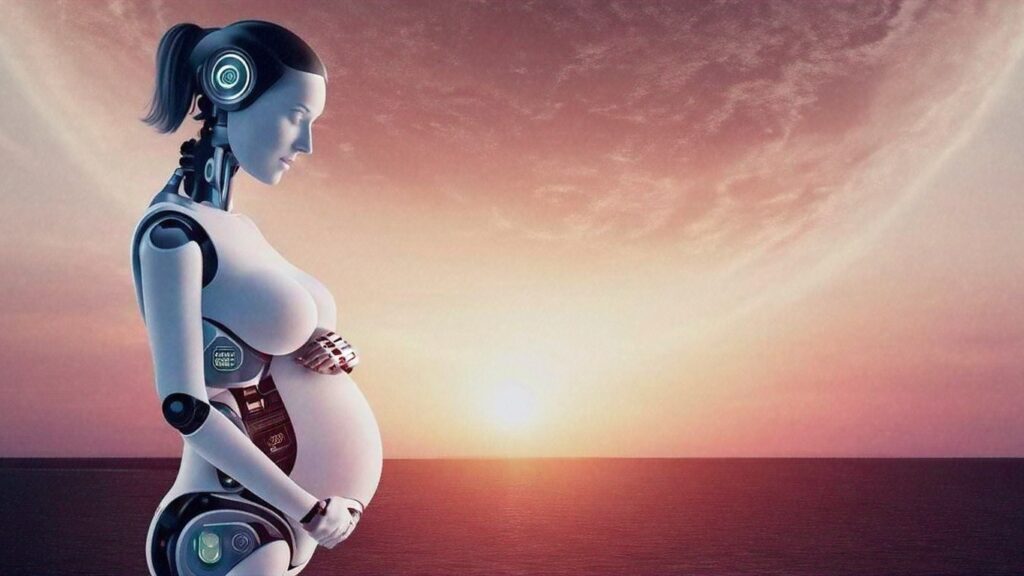Scientists develop world’s first ‘pregnancy robot’ that can give birth to living babies

Every so often, humanity creates something that makes us stop and question everything we thought we knew about life. Fire gave us warmth, but also destruction. The internet connected us, but also divided us. And now, on the horizon, comes another invention so radical that it forces us to ask: What does it really mean to be human?
Scientists in China have announced a humanoid robot designed not to cook, clean, or entertain—but to carry life itself. With an artificial womb embedded in its abdomen, this machine is being developed to nurture a fetus from conception to delivery. In just a few years, if its creators succeed, the first babies could be born not from a mother’s body, but from the hands of technology.

The Birth of a New Era in Reproduction
At the 2025 World Robot Conference in Beijing, the audience witnessed a revelation that sounded more like science fiction than science fact: the unveiling of the world’s first humanoid “pregnancy robot.” Developed by Kaiwa Technology, a firm based in Guangzhou, this machine is designed with an artificial womb embedded in its abdomen. Unlike previous innovations that merely supported premature infants, this technology aims to carry a fetus through all stages of pregnancy and deliver a living baby. Dr. Zhang Qifeng, the founder of Kaiwa Technology and a researcher affiliated with Nanyang Technological University, described the project as a leap beyond incubation—it is a full-scale attempt to recreate the miraculous process of human gestation through robotics and biotechnology.
The machine’s core design centers on artificial womb technology. Inside its hollow abdominal cavity, a fetus would be immersed in a carefully engineered fluid, replicating amniotic fluid, while nutrients and oxygen would be supplied through tubes that mimic the umbilical cord. The goal is to provide an environment so precise and stable that the fetus could grow safely over the course of ten months, free from many of the risks associated with human pregnancies. In theory, the process would allow conception, implantation, gestation, and delivery to take place without a biological mother’s body. While these claims are ambitious, Dr. Zhang insists the underlying science is already mature in laboratory experiments and only requires integration into a humanoid form for real-world application.
Kaiwa Technology plans to release its first prototype within a year, with an anticipated market launch by 2026. Even more striking is the projected price tag—under 100,000 yuan, or roughly $14,000. That cost, significantly less than many fertility treatments today, raises the possibility that such machines could become widely accessible in the future. To prepare for this reality, Zhang has reportedly initiated discussions with government authorities in Guangdong Province, with early policy proposals under review. By combining scientific advancement with legislative foresight, the company aims to legitimize and regulate a future where artificial pregnancy is no longer confined to medical laboratories but enters homes and clinics.
The potential impact of such a device is enormous. For couples struggling with infertility, same-sex families longing for biological children, or women who wish to avoid the physical toll and medical risks of pregnancy, the pregnancy robot represents a radical alternative. Yet with its promise comes unease. The announcement has already sparked waves of global debate, with some hailing it as a breakthrough for reproductive freedom and others warning of its ethical and societal consequences. Beyond the technical marvel lies a deeper question: if a robot can give birth, what does that mean for the future of parenthood, human intimacy, and the very essence of life itself?

The Science Behind Artificial Wombs
The concept of creating life outside the human body may sound futuristic, but scientists have been exploring it for years. In 2017, researchers at the Children’s Hospital of Philadelphia demonstrated what was once unthinkable: they kept a premature lamb alive and growing in what they called a “biobag.” This transparent sac was filled with artificial amniotic fluid, and the lamb received nutrients and oxygen through tubes connected to its umbilical cord. Over four weeks, the lamb developed wool, practiced breathing, and continued its growth as though it were still inside its mother. That experiment, though limited to animals, proved that artificial gestation could move from theory into reality.
Despite these advances, the science is far from complete. Current artificial womb technologies are designed to support life only after partial gestation, essentially acting as a bridge for premature infants rather than replacing pregnancy entirely. To replicate the full cycle—from fertilization to birth—scientists must overcome immense biological and technological hurdles. How do you ensure proper implantation of an embryo in an artificial environment? How do you replicate the nuanced hormonal interactions of a human mother and fetus? These questions remain unanswered, and without them, full-scale ectogenesis—the ability to create life outside the body—remains an aspiration rather than an achievement.
Dr. Zhang’s pregnancy robot attempts to move beyond these limits by merging artificial womb research with robotics and artificial intelligence. Instead of a sterile lab environment, the gestation would take place in a life-sized humanoid designed to mimic not just the internal conditions of pregnancy but also aspects of human interaction during the process. The machine’s sensors and AI would continuously monitor fetal development, adjusting nutrients, temperature, and fluid balance in real time. This approach attempts to bridge a crucial gap: providing the fetus with both physical support and an external “presence” resembling that of a human caregiver. Whether this distinction is meaningful biologically or psychologically is still an open question, but it marks a dramatic shift in how we imagine artificial reproduction.
If history has shown anything, it is that technology often moves faster than our collective readiness to handle its consequences. The science of artificial wombs demonstrates humanity’s extraordinary ingenuity, but it also forces us to confront a deeper reality: we are inching closer to redefining one of the most intimate and natural processes of life. Just as in vitro fertilization once pushed the boundaries of what was possible and sparked controversy before becoming commonplace, artificial gestation may follow a similar trajectory. Yet unlike IVF, which still relies on the human body, this technology imagines a world where birth itself is entirely separated from it.

The Ethical Dilemmas
Whenever technology touches the origin of life, the questions extend far beyond science. The pregnancy robot raises profound ethical dilemmas that cannot be ignored. On one hand, it offers hope for individuals and couples facing infertility, same-sex partners who wish to have biological children, or women who want to avoid the health risks and physical toll of pregnancy. On the other, it challenges our very definition of motherhood, fatherhood, and the human role in reproduction. If machines can carry and deliver babies, do we risk diminishing the value of pregnancy as a uniquely human experience?
Ethicists warn that separating gestation from the human body may open the door to commodifying life itself. When childbirth becomes a service that can be outsourced to a robot, it risks being treated less as a sacred process and more as a transaction. This concern echoes debates around surrogacy, but the robot intensifies it by removing the human surrogate entirely. Would parents see their child as the result of love and sacrifice, or as the outcome of a technological product purchased for $14,000? These questions strike at the heart of human dignity and identity, forcing us to rethink the boundary between innovation and exploitation.
There are also serious concerns about inequality. While Kaiwa Technology claims its robot will be relatively affordable compared to medical alternatives, the reality is that access to such technology would likely remain limited to wealthier individuals and countries in its early stages. This raises fears of a new form of reproductive divide, where some can choose to bypass the burdens of pregnancy while others cannot. If society embraces these machines without careful thought, we may unintentionally deepen existing inequalities in who has the ability to shape and control family life.
Furthermore, legal and moral frameworks are struggling to keep up. Who would bear responsibility if something goes wrong during artificial gestation? What rights, if any, does a fetus growing inside a machine have compared to one growing in a human womb? And how should society regulate the use of such devices to prevent abuse? These questions highlight the fact that innovation often outpaces law, leaving humanity to wrestle with dilemmas we are not fully prepared to resolve. In many ways, the ethical debate is as urgent as the science itself—because even if the technology succeeds, the world must decide whether it is ready to use it.

Beyond Reproduction—The Wider Implications
The development of a pregnancy robot is not an isolated event. It is part of a much broader trend where artificial intelligence, biotechnology, and robotics converge to reshape what we consider natural. At the same World Robot Conference where Dr. Zhang unveiled his vision, researchers also introduced GEAIR, the world’s first AI-powered breeding robot for crops. Using genetic editing and autonomous pollination, GEAIR can create hybrid seeds at unprecedented speeds, potentially revolutionizing global agriculture. These advancements show how technology is not just solving immediate problems but fundamentally altering the rhythms of life itself—from the way we grow our food to the way we bring new humans into the world.
In this light, the pregnancy robot becomes more than a medical or personal innovation. It represents a shift in how humanity relates to creation. For centuries, birth has been one of the few processes that remained largely untouched by machines. Now, with the possibility of artificial wombs, even this realm may be transformed. Such a change will ripple far beyond biology, influencing culture, religion, economics, and politics. Different societies may interpret the technology through vastly different lenses: some may embrace it as liberation from natural limits, while others may resist it as a violation of sacred order.
At the same time, there is a practical side to this transformation. As populations in some countries age and birth rates decline, governments may see technologies like pregnancy robots as potential tools to boost population growth without placing additional burdens on women. This utilitarian approach could accelerate adoption, but it also risks reducing children to instruments of demographic policy rather than cherished lives. On the flip side, in contexts where overpopulation is a concern, such technologies could fuel fears about accelerating growth beyond sustainable limits.
By stepping back, we can see that the pregnancy robot is not just about family or fertility—it is about the kind of future we are building. It forces us to ask whether technological progress should always be pursued simply because it is possible, or whether some frontiers should be approached with restraint, humility, and caution. The conversation around artificial gestation is, in truth, a conversation about our collective values as a species.
A Call to Reflect
Whenever humanity stands at the edge of a new frontier, we are asked not only what we can do, but what we should do. The pregnancy robot is one of those frontiers. It offers extraordinary possibilities for families longing for children, for individuals facing medical barriers, and for societies wrestling with reproductive challenges. Yet it also carries risks that go beyond science—risks to our ethics, our equality, and our very sense of what it means to be human.
As we watch technology advance, it is easy to be swept up in excitement or fear. But perhaps the real challenge is not to rush to either extreme. Instead, we are invited to pause and reflect: what values do we want to guide us as we step into this new era? Do we want a world where machines can create life without reflection, or a world where we balance progress with wisdom, ensuring that technology serves humanity rather than reshapes it beyond recognition?
History reminds us that every innovation carries both promise and peril. IVF was once controversial, yet today millions of families celebrate children born through it. At the same time, we have seen technologies misused when ethics lagged behind ambition. The choice before us now is not just about artificial wombs—it is about whether we will meet this moment with conscience as well as curiosity.
So, as you read these words, consider this: the story of the pregnancy robot is not just unfolding in labs and conferences. It is unfolding in the values we choose to uphold, in the questions we dare to ask, and in the courage we show to shape technology with wisdom. The real birth that matters may not be the child born of a machine—but the birth of a more thoughtful humanity, willing to decide not only what kind of lives we can create, but what kind of world we want those lives to inherit.
Loading...

